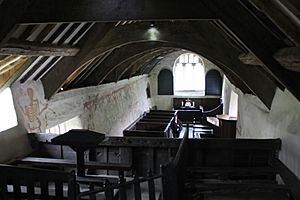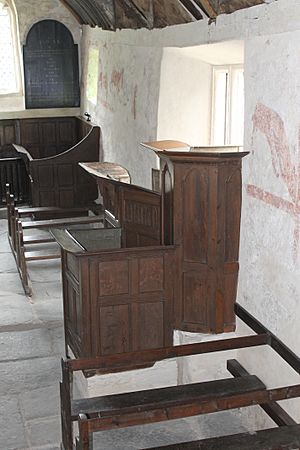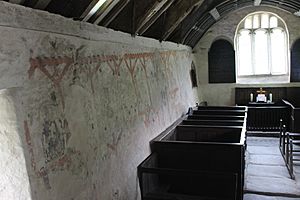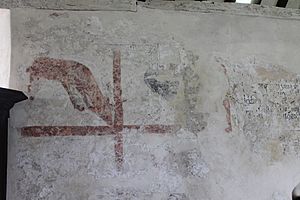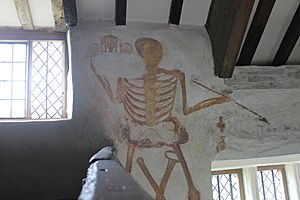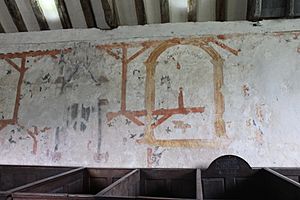All Saints' Church, Llangar facts for kids
Quick facts for kids All Saints' Old Parish Church |
|
|---|---|
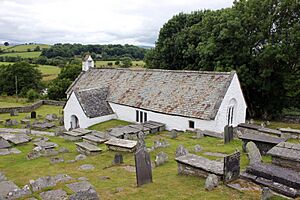 |
|
| Type | Church |
| Location | Llangar, Cynwyd, Denbighshire |
| Built | 15th century |
| Rebuilt | 18th century |
| Restored | 1974 |
| Restored by | R. Shoesmith |
| Governing body | Cadw |
|
Listed Building – Grade I
|
|
| Official name: Church of All Saints, Cynwyd | |
| Designated | 1966 |
| Reference no. | 704 |
| Official name: Llangar Old Parish Church & Churchyard | |
| Reference no. | ME093 |
| Lua error in Module:Location_map at line 420: attempt to index field 'wikibase' (a nil value). | |
Llangar Church, also known as All Saints Old Parish Church, is a very old church in the Dee Valley, North Wales. It used to be the main church for the areas of Llangar and Cynwyd. Today, it's looked after by Cadw, a Welsh government body that protects historic sites. It's a special building, listed as a Grade I building and a Scheduled Monument. You can visit it to see its amazing medieval wall paintings and its 18th-century inside, which is still mostly how it was back then.
Contents
A Look Back: The Church's History
People know there was a church in Llangar as early as 1291. But the church building you see today was mostly built in the 15th century (the 1400s). Digs inside the church in 1971 showed this was the earliest time people used the spot.
The church has one main open space, combining the nave (where people sit) and the chancel (near the altar). It has a floor made of flat stones. The roof is a special type called an arch-braced roof, with wooden beams from the 15th century. The walls are covered with old paintings. These paintings probably have at least eight different layers, with the oldest ones also from the 15th century. Inside, there's a lot of old wooden furniture, like a gallery, box pews (seats with high sides), benches, and a pulpit (where sermons are given). All of these wooden pieces were added in the early 1700s.
By 1856, most people in the area had moved further up the valley to Cynwyd. The old church was far away and falling apart. So, people decided to build a new church, St John Evangelist, in Cynwyd. This meant the old Llangar Church was left alone. Because it wasn't updated in the 1800s, it kept its original look. It became very run down, but then Cadw took over caring for it. A big project to fix and protect the church started in 1974.
The Church Roof: Old Timbers
The oldest parts of the roof are four arch-braced wooden beams. These form the four main sections in the middle of the church. At the back, above the gallery, some roof beams were changed in the 1600s or 1700s. These are divided by a different type of beam called a collar-beam truss.
At the front, near the altar, the roof is covered with wooden panels. This creates a barrel-shaped ceiling, like a "canopy of honour." This design is from the 15th century, even though some of the wood is newer.
Inside the Church: Wooden Wonders
The inside of Llangar Church has many wooden fittings from the early 1700s. Because the church was later left empty, these pieces survived almost perfectly. In other churches, people in the 1800s often threw out old furniture to make things look new.
At the back of the church, there's a large wooden gallery. You can reach it by a stone spiral staircase. The gallery has wooden benches for a choir and a special enclosed area with a music stand.
In the main part of the church, you'll see box pews. Some of these pews face the front (east). Others, next to the pulpit, face south towards the pulpit. This shows how important the pulpit and sermons were back then, even more than the altar where the Mass was held. The pulpit itself is on the south wall. It's a special wooden piece that combines three things: the pulpit, a reading desk, and a clerk's desk. It was put together using older pieces from the 1600s.
Amazing Wall Paintings
The north and south walls of the church have old wall paintings. These are just small parts of what used to be there. There might be as many as eight different layers of paint, from the 15th to the 18th centuries.
Before the Reformation (a big change in the church in the 1500s), the main paintings were long scenes. On the north wall, you can see a series of rustic frames, like wooden picture frames. These probably held pictures, maybe showing the story of Jesus' suffering. It's hard to tell exactly what the pictures inside the frames were. Also on the north wall, on top of some of these frames, is an older painting of a bishop. He's standing in a fancy painted "niche" (a carved space).
The south wall is split into two rows of seven rectangles. In the top row, there seem to be pictures of the seven deadly sins (like pride or greed). In the row below, there's a matching series of seven works of mercy (like feeding the hungry). This was a common theme in medieval wall paintings.
In Llangar, each of the seven deadly sins seems to be shown by a person riding an animal. Only three churches in Britain use this idea! The other two are in Hardwick, Cambridgeshire, and Imber, Wiltshire. Like many old wall paintings, large parts of the Llangar paintings are gone or covered up. In some scenes, you can still see the riders' hats and the animals, but the riders themselves are unclear. They might have been damaged on purpose long ago.
Other paintings around the church were done after the Reformation. These were painted over the older medieval images that were no longer allowed. The most noticeable and newest painting is a large skeleton figure of Death. It was painted in the 1700s to remind people that everyone will die.
On the north wall, there's a classical arch frame with the words of Gweddi'r Arglwydd, which is the Lord's Prayer in Welsh. These different texts on the walls show a change after the Reformation. People started focusing more on words than on pictures. This also matches how the church's inside layout changed, with more focus on the pulpit than the altar.
There are no paintings on the two end walls of the church. This is because these walls had problems and were rebuilt around 1615–1620. The south porch was also added then. The west wall has even been rebuilt twice since then. The paintings on the two long walls show that these walls have stayed the same since the oldest paintings were made.
When the paintings were protected in 1991, they found many images from different time periods. Experts had to decide which layers of paint to keep and which older ones to uncover.
Cadw: Protecting the Past
Llangar Church is a 'Guardianship monument'. This means that Cadw is now in charge of the church building. Before, it was part of the St Asaph Diocese of the Church in Wales. The church can still be used for two services each year.
Responsibility for Llangar Church went to the Secretary of State for Wales (who was in charge of what is now Cadw) in 1967. A project to study and protect the church started in 1974. Archaeologists dug under the stone floor, led by Ron Shoesmith. They didn't find any proof of the church being there before the 1300s.
The building was made strong and waterproof. Then, in 1991, the work to uncover and protect the wall paintings was finished. Visitors can see the church by arranging a visit with the Cadw staff who work at Rug Chapel nearby.
See Also
- Grade I listed buildings in Denbighshire
- List of Cadw properties
- List of Scheduled Monuments in Denbighshire
Images for kids


